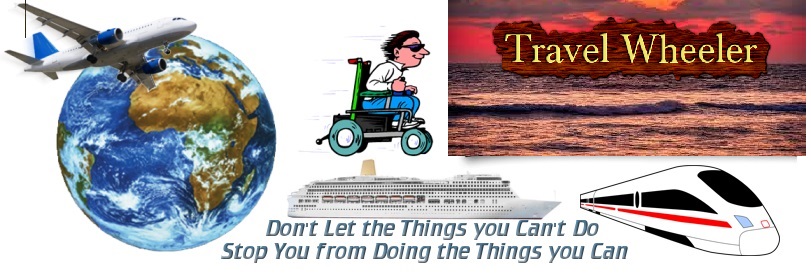
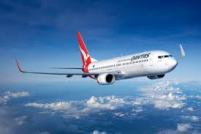
AIRLINES
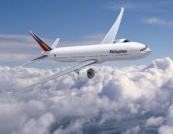
When booking the flight if your have a mobility disability make absolutely certain that you specify that you require wheelchair assistance and you specify this to the airline at the time of booking, if for some reason you did not do that, then call the airline and inform them and ask if they would be able to resend the airline reservation to you with the updated request on it. There are different degrees of assistance, I have always requested wheelchair assistance cannot climb stairs, and also noted the fact that I was traveling with my own wheelchair. An additional notation would be if you require assistance on the plane.
The first thing that I cannot over stress enough, arrive at the airport early. It is always better to be too early then rushed by arriving too late. I always try to arrive at the airport 3 hours prior to the flight, and plan to leave home or hotel with enough time to arrive at the airport 3 hours before the flight. You have to be prepared for the unexpected such as traffic or your ride not on time. This is even more important when traveling with a mobility device or scooter.
Some hate waiting around the terminal building a lengthy time period for their flight and would rather wait or sleep in longer before coming to the airport, but I know from experience that I have been on both end of the stick as they say, and sometimes have gotten thru to the departure gate with a lot of time to spare, but I have also have had times when there was little time to spare at all and was rushing all the way.
BEFORE YOU LEAVE

Clothes that you wear
Wear slug fitting pants, you may be asked to remove your belt at airport security, and it would be nice if the pants are not too loose once the belt is removed and can stay on as you walk thru the metal detector. Persons in wheelchairs or scooters will be inspected manually from a sitting or near sitting position and therefore may not have the same degree of concern, but it still would not hurt to wear not too loose of clothing when it comes to pants
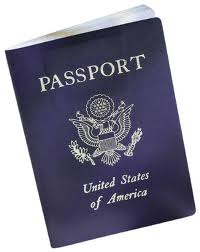
Passport
Important documents should stay with you in your carry on. Passports, airline tickets should be easily accessible. They usually recommend that you carry prescriptions on you (with carry on) but you must have a copy of the prescription with you if not attached to the medication itself. Any medications that I take are not critically life threatening if I where to lose them and always just put them in the check in luggage so there is less possible questions going thru security. Some people however do have more critical prescriptions such as diabetic medication and would present a major health concern if they where lost. This is one area you should consult with the airlines as rules do change, the handling of needles for instance could be considered a security issue on board therefore you need to consult with the latest procedures with the airlines directly on this.

Luggage
Not all airlines have the same check-in luggage rules, and it can also vary according to the class of ticket you purchased. Be aware of how many free luggage bags are allowed, some have no free luggage allowed and each piece is an extra charge. So always be sure to know this and the max weight allowed.
Most people will not have a scale at home that will accurately weigh your luggage, bathroom scales are not designed for this, they will only provide a ball park idea of the weight, your check in bags will be accurately weighed at the airport, and you will be charged an additional fee if overweight which is usually a lot higher than checking in an additional piece of luggage, check the information on the airline website for fees. It also burns up time if you have to move luggage contents around when you find out one piece is overweight and the other is underweight. Be aware on the limitations & restrictions for carry on pieces. Also fees paid at the check in counter in regards to overweight charges or baggage fees are paid by credit card or if paying in cash make sure you have exact cash as they may not be able to provide change.

Medical Implants?
If you have a medical implant, always carry an official signed letter from the doctor or clinic explaining the details of what the implant is, it is far better to have this and not need it then to need it and not have it. These devices may trigger any magnetic walk thru detectors at the airport, and therefore you must notify security as soon as you get there of that fact. Sometimes it is not advisable to even go thru a metal detector at all as it may cause uncomfortable sensations, tell the security personal of that fact and they will route you past the metal detector and check you manually. Females will be checked by a female security officer and males by male security officer, you can if you so wish request that you be checked in private.
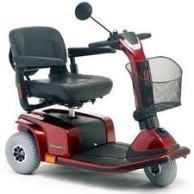
Mobility Devices
For a powered mobility device such as a power wheelchair or scooter, prepare detailed instructions on how the mobility device disassembles and reassembles. There is usually a pouch on the back of the seat of most wheelchair and scooters that you can put this in and close the snap cover on it. This will assist the ground crew if the need arises that some disassembly is required.
As an example here are the instructions I had prepared and left in the pocket on the back of the seat?
(requires adobe acrobat reader to be installed, can be obtained for free from ADOBE)
Also note that mobility devices such as wheelchairs and scooters are checked in for free and do not count towards your baggage limit.
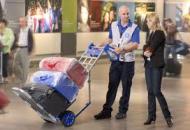
Porters
Make sure you have some small denomination currency on you for tips. Even more important if you have a disability and need help in carrying luggage. In Toronto, Canada the charge for carrying 3 pieces of luggage from the baggage area thru customs and onward to the connections drop off was $ 10 for the 1st 3 pieces and $ 2 for each piece after that. I would carry 10 dollars in ones and a couple of tens and perhaps 3 or 4 in 5 dollar amounts. Most of which will not likely need but it is nice not to be caught with only twenty?s on you. Some self serve dollies cost 1 to 2 dollars to get the dolly and you may or may not get a portion of that back when returning it. However the snag is that sometimes it requires coins other times it will accept paper money. US dollars is always a good fall back for paying for porters if you do not have the local currency on you.
AIRPORTS
Getting to the Airport
At home you will be taking a taxi or maybe another family member dropped you off, unless you are prepared to pay for extended parking right at the airport. You may be traveling with a companion / spouse, you may have 2 to 4 pieces of luggage between you, a mobility device such as a wheelchair or scooter, and sometimes you have to partly disassemble a travel type scooter. The pickup service may have messed up and instead of coming with an accessible vehicle came with one not accessible. So again I say again make sure to plan to get to the airport early.
At the Airport
MAKE CERTAIN WHENEVER SOMEONE TAKES YOUR TICKETS / ID OR PASSPORTS THAT YOU MAKE SURE THAT YOU GET THEM BACK AND CHECK TO BE CERTAIN THEY ARE YOURS. THERE ARE LARGE NUMBERS OF PEOPLE BEING PROCESSED AND YOU DO NOT WANT TO FIND OUT LATER YOU HAVE SOME ONE ELSE’S PASSPORT AND NOT YOURS.
You have to check in your luggage, some airlines have curb side check-ins at some airports others do not, if you are alone using a mobility device you need to get the attention of a porter to bring your luggage to the check-in counter, if you are not traveling alone, the other person may be able to get a dolly for the luggage. Sometimes there can be lineups to the check-in counter other times not. People using a mobility device along with there traveling companions can often go to a special route to the check-in cutting out a lot of the lineup. Then time to check ID, tickets, weigh luggage and check it in, and heaven forbid is one piece is overweight and another is not and you end up having to transfer part of your luggage over to the other one or have to pay you over weight items, that all burns up time.
If you have a manual push type wheelchair they will likely transfer you to a airline supplied wheelchair and take yours at the check-in, and an airport worker will push you and take you thru security and to your gate. Do yourself and your traveling companions / spouse a favor if you are traveling with a manual push wheelchair no one should volunteer to push you, let the airport staff push you to and thru security and to the gate and let your traveling companions just follow you and to help with the carry on pieces that you cannot carry on the wheelchair.
If you have a powered wheelchair most times they allow taking your wheelchair or scooter to the gate itself, if saves staff time by allowing powered devices to just proceed on their own, plus it allows you to move around the terminal some after you found your gate until the flight gets close to boarding. Using the electric scooter I was able to hang most of the carry on pieces over the cane in the back of the scooter, helped my wife a great deal so she did not have to carry as much. But it does make the scooter back heavy which makes you more prone to wheelies tip backs in a bump and steep incline situation if taken too fast but airport inclines should not be steep enough to be a major concern, and not major bumps in the way just slow down if you do cross these situations.
If you have a powered mobility device, you will be asked what kind of battery you have, if it is a dry or wet cell as it requires different handling procedures for the baggage and ground crew. The preference is dry cell batteries (gel), some types of batteries are normally not allowed, but mobility devices often have exceptions with the airlines. My scooter has a removable sealed battery box that I have no reason to take apart, the specifications indicate “AGM or Gel cell “, when asked if it is a wet or dry cell battery I always say dry which can also be referred to as gel.


Security
Security may be on another floor or another section of the airport, ask at the check in counter for directions.
If you have any need to go to the restroom go before security (after all you should have arrived at the airport early so you are not rushed)
There are usually special routes for disabled passengers and their companions so the line is much shorter.
Make certain that as soon as you enter security you make them aware of any medical implants and rather you can go thru the metal detector, supply a medical letter regarding the implant if asked for, it is not always asked for but you still should have it just in case.
All contents of your pockets including wallet, carry on bags, money belts, cameras, cell phones, canes, anything in the basket of your wheelchair or scooter must be placed on a conveyer belt to pass thru an x-ray machine. If you need assistance ask for it. Sometimes (but not always) they may want to pass your pants belt thru the x-ray. Make certain that cell phone / laptops have fully charged batteries before coming to the airport, security may check to confirm they are working units. Laptops are often required to be removed from any bag and passed thru the x-ray unit out of its carrying case.
Now this may be fast or it could take some time. However to be manually screened you need to have a male officer if screening a male and a female officer is screening a female, and it can take a few minutes at times to free up an officer of the appropriate gender to screen you. You may be asked if you are able to remove your shoes, if it is difficult or you have a brace on like I do, I just say that I have a brace on and it will take a few minutes to do it, and they will usually say it is ok, and allow you to leave the shoes on and do the check with them on.
Make certain after the screening that you collect all your carry on bags, pants belt if your removed it, and make certain that you have your wallet, money belt, cameras and documents, check that the passport tickets / boarding pass is actually yours.
Getting to the gate
Once thru security you must find your gate, in some airports that may involve taking a tram or mono rail to another section of the airport. Follow the signs.
If you had turned in your own wheelchair at the check-in and an airport worker is pushing they will move you thru security and get you to the gate and onto the plane. If the gate number gets changed someone will come and move you to the new gate. If you have a powered wheelchair or scooter, you will likely be navigating on your own to the gate.
Check every so often to be sure that the gate number does not get changed. Also make certain that as soon as someone is at the gate desk that you go up and inform them the fact that you have a wheelchair or scooter to take (if you have your own powered wheelchair / scooter), and ask if they are taking it at the door of the plane or are they going to take it at the gate waiting area and they then put you in a airport manual wheelchair and push you to the plane door, most times I have been able to take the scooter to the planes door but there has been instances that they wish to take it earlier in the gate waiting area. Often at the original check in when you came into the airport made note of it, but it is always best to make sure the person at the gate desk is reminded so that he or she will further make arrangements with the ground crew. You will be asked if you can manage once you are on the aircraft, in my case the seats are close enough together, I can get to the seat on my own once I am inside the aircraft. If you cannot get to the seat on your own they will transfer you to a narrow wheelchair and you will be pushed to your seat.
Make certain that they tag your wheelchair or scooter for delivery to gate so when you land the mobility device will be delivered to either the planes door or to the gate waiting area in which case they will bring you up the ramp to the waiting area in an airport wheelchair. If it is not tagged to deliver to gate it may go to the baggage pick up area. That tagging may be done at the original check in or at the gate desk, ask this at both locations.
Now if you completely have no use of your legs and cannot walk at all then you may need to be lifted between mobility devices and to and from your seat. The aircraft carries a special wheelchair that is narrow that will fit down the aisle of the plane. Now the first time that I saw this was on Nov. 26 2010 with a flight between Toronto Canada and Ottawa Canada, I was on the plane first and never notice the person coming on, but while waiting for my scooter to arrive at the destination I did see the other person waiting for his power wheelchair, and could not walk on his own, he had around him a cloth carrying thing (not sure what it is called) with 2 handles on each side that would go part way up the back and under him and 1 or more persons would go on either side of him / grab the handles and lift and transfer this person to and from the wheelchair. They usually want a person with no walking ability to be in the aisle seat.
Disabled persons are the first to board but are the last to get off the plane, so please if at all possible try and give yourself some time between connecting flights, and hope the ground crew does not screw up and send the wheelchair or scooter to the baggage area instead of to the gate, mention that to the cabin crew as soon as you land that you are waiting for your wheelchair or scooter to arrive at the gate and if they could remind the ground crew to bring to the gate or aircraft door. Also mention if you have another flight soon so they make it a priority.
Most of the flights I have taken they have been quite good at getting the scooter to the gate as quick as possible. At one airport when time was tight there was a person waiting in the airport hallway keeping an eye out for the scooter as they wanted to make certain the scooter got onto the flight and took it immediately so the ground workers could route it to the plane storage under the plane.
The one place that messed me up three times was Ottawa, Canada. Back in 2008, flying from Kingston Jamaica to Ottawa Canada (changing planes in Toronto) the plane from Jamaica to Toronto had issues with the door, and as a result engineers had to repair which took several hours and the flight from Toronto to Ottawa was changed several times, as a result the order was not put in that I required wheelchair assistance when the flights got changed. So when I got to Ottawa no one was waiting with a wheelchair as the manual wheelchair I had at the time went to the luggage area, it took 40 minutes to get a wheelchair to arrive to bring me to the luggage area.
In that same year another trip coming back to Ottawa the foldable wheelchair I had did not show up in Ottawa at all, and only one piece of luggage, the next flight that came I got 2 more pieces, they put a rush on finding it, and a couple of days later the wheelchair and remaining pieces was delivered directly to my house.
Now this year Nov 2010 there was a tag on the scooter to have it delivered to gate in Ottawa, and we where waiting on the plane forever and my daughter eventually called me saying it had been in the baggage area for the last 20 minutes, so finally they got a wheelchair to bring us down to the luggage area where I could retrieve the scooter. Once they mess up and brought it to a baggage area they are not allowed to bring it back to the gate without going thru security. If that had happened in Toronto I would have missed the flight to Ottawa. So do not think you are nagging if you ask the crew immediately upon landing to remind the ground crew to bring your powered mobility device to the gate.
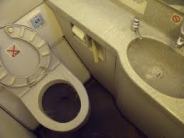

On the plane restrooms
Remember the airplane stewards on the plane are not nurses, they will assist you in anyway they can and help transfer you from the seat to the narrow airplane wheelchair and get you to the restroom and back, but you are on your own in the restrooms itself, if you require assistance in the restroom itself you have 2 options, ( a) travel with a companion that can assist in this regard or (b) travel in short flights that will break up the travel where you can use your own wheelchair at the terminal buildings where larger better equipped restrooms may be available. Airplane restrooms tend to be small, some aircraft have at least one slightly larger wheelchair designated restroom but I use the word slightly larger but gives a little more room from the small aircraft wheelchair to get into and will have some support bars in them. If this is a concern then research which aircraft have better wheelchair accessible restrooms in them, make sure you go to a restroom in the terminal prior to boarding the aircraft. Consider the location of which seat you select and if you feel you need a seat close to the restroom then make sure you pre-book that seat.
By: Donald Kerr